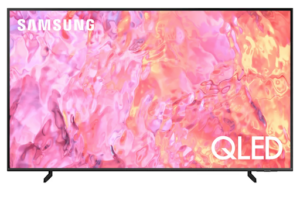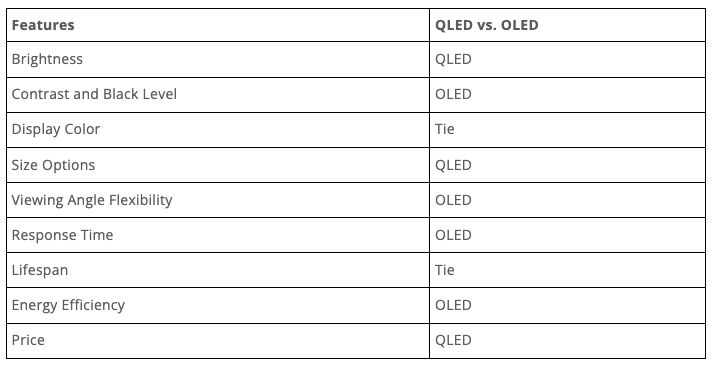
Get the Big Picture: QLED vs. OLED vs. UHD TVs
Is it time to upgrade your TV? These days, television technology is truly spectacular — and it’s only getting better. But with all of this progress comes a ton of confusing acronyms and terminology that only seem to complicate your TV-buying experience.
That’s why we put together this helpful guide to get you up to speed on the important differences when it comes to QLED vs. OLED vs. UHD TVs. We’ll help you determine if QLED is worth it, or if OLED is more suited to your needs — or if you just want to keep things simple with a UHD TV.
What Is QLED?
Though their names are only one letter apart, QLED and OLED are fundamentally different technologies — but both of them are UHD. Choosing one over the other will lead to distinctly different viewing experiences. If you’re confused, don’t worry — we’re about to clear everything up. First, let’s start with some simple definitions.
QLED stands for “Quantum Light-Emitting Diode.” The word “quantum” refers to the use of tiny particles called quantum dots, which, when hit by light from the TV’s LED backlight, emit their own spectacularly bright light and colors — also known as “transmissive” light.
In a QLED TV, the light from the LED panel travels through a quantum dot screen (among other layers) before reaching the liquid-crystal display (LCD) at the front of the TV where our favorite shows and movies turn into recognizable images. All modern televisions, except for OLED TVs, use LCD screens that are lit up by an LED backlight.
Experience your favorite shows and movies in remarkable detail with the latest in Quantum technology:
- Quantum Dots provide 100% Color Volume for stunning color and brightness
- Quantum Processor 4K dramatically improves contrast, shadow detail, and color accuracy
- Netflix recommended TV that works seamlessly with voice assistants like Google Home and Amazon Alexa
What Is OLED?
OLED stands for “Organic Light-Emitting Diode.” What makes OLED technology fundamentally different when compared to QLED is its “organic” source of light. While QLED TVs use an LED backlight to brighten each dot on the screen, each dot IS its own light in OLED TVs. The LED pixels in OLED TVs are super thin and capable of producing their own bright lights and colors — what the industry calls “self-emissive” light.
This difference in display technology — self-emitting (OLED) vs. transmissive light (QLED) — leads to all sorts of variations in image quality, energy use, and so on. We’ll get into the specific distinctions between these two leading TV technologies in just a moment. Before that, let’s quickly clear up any misconceptions surrounding the term “UHD.”
What Is UHD?
UHD stands for “Ultra High Definition.” This simply refers to the TV having a 4K display resolution (though now there are some UHD TVs out there with an astounding 8K resolution). TV resolution is the picture quality of your TV screen and is determined by how many pixels are used to create the image you see. The more pixels there are, the sharper and clearer the picture will be. For instance, 8K resolution TVs have more pixels than those with 4K resolution.
UHD is not a “new” type of TV technology like OLED or QLED, but rather an improvement on the “full HD” 1080p LCD (liquid-crystal display) TVs that are now standard. A UHD TV operates like a QLED TV in that it has an LED backlight and LCD screen, but it lacks the QLED TV’s quantum dots used to improve color and brightness.
The most important thing to remember is that UHD is not technically a type of TV, but rather a description of its 4K resolution. And although UHD and 4K are not the same, the terms are often used interchangeably. Finally, while UHD TVs do not necessarily include QLED or OLED technology, almost all modern QLED or OLED TVs offer UHD resolution!
Take movie nights to a whole new level with all the features this 4K ultra-high-definition Crystal UHD TV has to offer:
- PurColor technology uses millions of shades of color for an incredibly vibrant picture
- Enhanced contrast for greater depth and lifelike details even in the brightest and dimmest of scenes
- With Smart TV powered by Tizen built in, you can find and stream the latest shows in a few easy clicks
The Differences Between QLED, OLED, and UHD, In a Nutshell
To summarize, these are the biggest differences between QLED, UHD, and OLED TVs:
- QLED technology uses an LED backlight to hit a screen of quantum dot particles that then supercharge the TV’s pixels for brightness and color.
- OLED technology removes the backlight in favor of LED pixels that emit their own vibrant light and colors independently. It does not use an LCD.
- UHD TVs are simply higher-resolution versions of the standard LCD TV. Both OLED and QLED TVs usually offer UHD resolution.
QLED vs. OLED: Which Is Better?
Now that you have a better understanding of how the technologies differ, check out how QLED and OLED TVs compare. Below are the pros and cons to consider when it comes to picture quality, lifespan, price, and more.
Brightness
When it comes to brightness, QLED TVs beat OLED. Thanks to their powerful LED backlight, QLED TVs are capable of producing much brighter light than the individual LED pixels in OLED TVs. And since the QLED’s quantum dots reach more vivid hues in the color spectrum, the colors on the screen won’t appear washed out — even in the brightest of rooms.
Winner: QLED
Contrast
The OLED wins out when it comes to contrast and black level. QLED TVs must block light from their LED backlight to make a scene appear darker, and even the best models suffer from blooming — where small amounts of light spill into the wrong areas causing a halo effect. This leads to washed-out, grayer-looking black levels.
Meanwhile, OLED displays can simply turn off LED pixels that aren’t in use — and you can’t get any darker than no light at all! This means that OLED TVs are capable of producing infinite contrast, leading to greater depth and detail on screen. Perfect for taking your scary movie marathons to a darker level!
Winner: OLED
Color
Lastly, the question of color is still up for debate. Both QLED TVs and OLED TVs are known for the accuracy and range of pigments they display. However, QLED TVs may offer a better viewing experience in bright conditions, while OLED TVs are known for providing deeper and darker shades of black. Where OLED technology once ruled this category, nowadays, there is no discernible difference between the quality of the two TVs’ color processing.
However, a relatively new technology, QD-OLED (Quantum Dot Light Emitting Diode), may offer the potential for even greater brightness and color accuracy. QD-OLEDs are a hybrid TV display technology that combines the quantum dots of QLEDs with the OLED panel, cultivating the best of both worlds.
Winner: Tie
Size
In the world of TVs, bigger is almost always better. A bigger TV means a more immersive experience and better viewing for everyone involved. With that said, QLED TVs have a clear advantage over OLED.
Current OLED TVs only come in eight sizes. QLED TVs, on the other hand, offer a wider variety of size options from 32 inches to 98 inches. At Rent-A-Center, we have great deals on smart TVs in many brands and display sizes so that you can find the right TV size at the right upfront price with flexible payment options.
Winner: QLED
Viewing Angle
Everyone knows the sweet spot for watching TV is front and center. But what about the people who get left with a place far off to the side? You want to make sure they can have a great viewing experience too. If you love movie nights with friends and family, an OLED TV will ensure no one misses out on the action.
While OLED screens do not drop in picture quality even at the widest viewing angles, QLED TVs suffer from lost color and contrast the further away you get from a center viewing angle. Manufacturers have made efforts to remedy this problem, but it hasn’t been enough to beat OLED’s consistently clear viewing angles.
Winner: OLED
Response Time
In TV-speak, response times are how long it takes (in milliseconds) for a pixel to activate, deactivate, or change its output. Faster response time means the image on the screen will be crisper and quick to react to changes in color and light — as you would see during an action-packed chase scene.
In terms of response time, OLED TVs are generally much faster than QLEDs — something you’d want when playing video games, watching sports, or sitting at the edge of your seat during an action film. This is because OLED pixels are individually controlled and can instantly change color and luminosity rather than wait for a backlight to shine through multiple screen layers like on a QLED TV.
Winner: OLED
Lifespan
As these two technologies are still relatively new, it has yet to be seen which one has a longer lifespan. While there have been concerns about TV burn-in on OLED TVs, improvements have made this less of an issue.
But one thing is for sure: the LED backlight in LCD TVs (including QLEDs) has a proven track record of longevity and consistency. Nevertheless, you’ll likely get years and years of use from either model before it begins to decline in quality.
Winner: Tie
Energy Efficiency
QLED TVs have a lot more “stuff” built into them that requires power, including the LED backlight, the quantum dot screen, and several other layers. Not only does this make them bulkier than OLED TVs, it often makes them less energy efficient, too!
In contrast, the lack of a backlight and the use of super-thin LED pixels in OLED TVs allows them to be slimmer, lighter, and more energy-efficient than QLED TVs.
Winner: OLED
Price
As with any high-tech device, price is a factor to consider. Currently, QLED TVs have the advantage in price when it comes to mainstream TVs larger than 65 inches. For instance, a 77-inch OLED is likely to be pricier than a 75-inch QLED TV. Still, it’s worth noting that as more competitors enter the market with OLED TV offerings, the price difference between the rival technologies may start to even out.
Plus, with Rent-A-Center, you can get the QLED or OLED TV you really want at an upfront price and flexible options!
Winner: QLED
So is QLED or OLED Better?
While OLED TVs have a lot of perks — from superb black levels to more flexible viewing angles and quicker response times — QLED technology may fit those who enjoy bigger screens or have a brighter viewing area. Plus, QLEDs are likely going to be easier on your wallet.
Ultimately, choosing between these two TV technologies depends on your priorities and what suits your viewing area best. To help make your decision easier, here’s a comparison chart that breaks it all down.
QLED vs. OLED Comparison Chart
The Future of TV Technology
As technology continues to evolve, new advancements promise to revolutionize the way we experience television. Three emerging technologies that hold great promise are QD-OLED, mini-LED, and ink-jet printed (IJP) OLEDs.
- QD-OLED (Quantum-Dot Organic Light-Emitting Diode): As mentioned previously, QD-OLED blends QLED and OLED technology beautifully. By using quantum dots to emit light directly, they offer self-emissive lighting alongside improved brightness, color accuracy, and potentially reduced manufacturing costs.
- Mini-LED: Mini-LED technology enhances traditional LED backlit displays by using smaller LEDs, allowing for more precise lighting and contrast control. Mini-LEDs promise to bridge the gap between QLED and OLED displays, offering deeper blacks and a more immersive viewing experience.
- Ink-Jet Printed OLEDs (IJP OLEDs): Ink-jet printing technology — something to look forward to — allows OLED panels to be produced using inkjet printing techniques. The possible result? A more cost-effective and mainstream version of OLED TVs.
Head to Rent-A-Center for Great Deals on the Best TVs
Now that you have a clearer picture of the differences between QLED, OLED, and UHD displays, you probably know which type is right for you. Bring home the TV you want, all without using credit! You’ll also enjoy the benefits of free delivery and flexible payment options that are right for you!
And with our Worry-Free Guarantee, there’s no need to compromise on your first-choice TV. Shop online, or visit your local Rent-A-Center to upgrade your TV shopping experience today.
